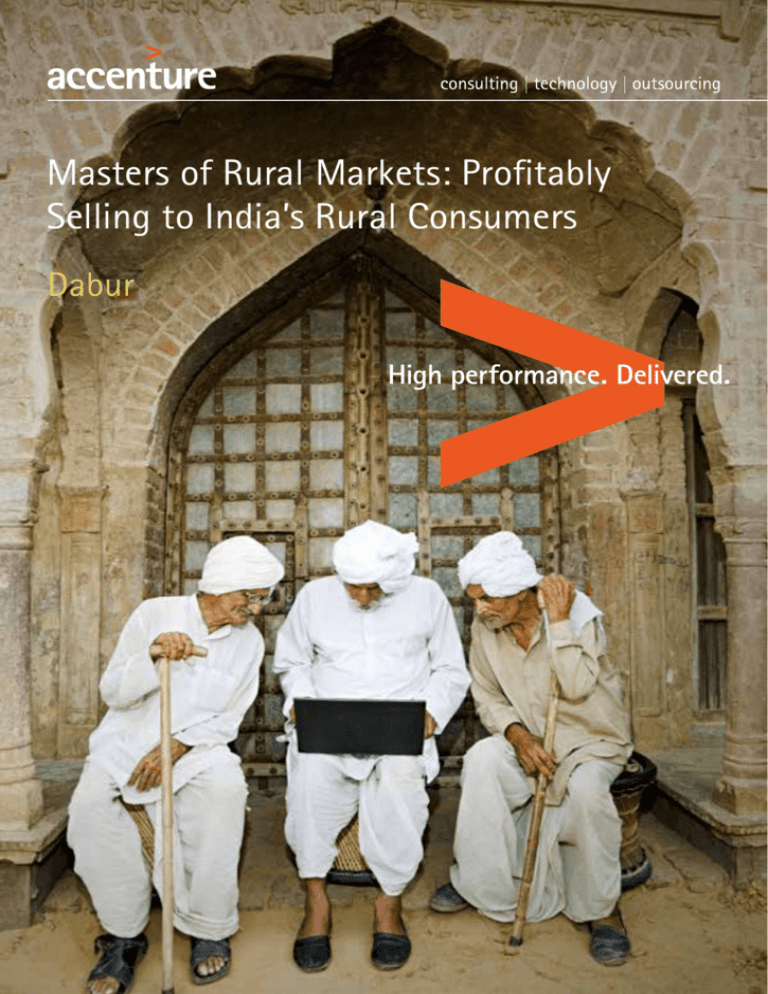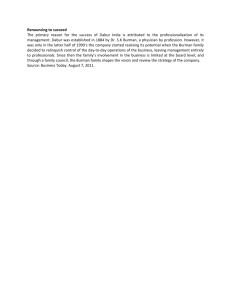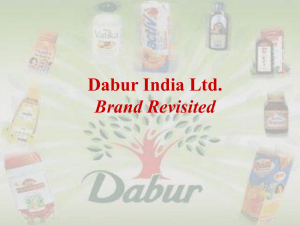Dabur - Industry
advertisement

Masters of Rural Markets: Profitably Selling to India’s Rural Consumers Dabur Dabur: Deploying Technology To Extend Reach Dabur is the world’s largest Ayurveda and natural healthcare company. With annual revenues in excess of US$1 billion and market capitalization of US$4 billion, it is India’s fourth largest fast-moving consumer goods enterprise. Dabur’s offerings are very popular in rural markets. Products such as Chyawanprash, Amla Hair Oil and Hajmola Digestives were developed based on insights the company gleaned about rural consumers. Sales in rural regions are particularly important to Dabur. In fact, about 47 percent of its sales in terms of consumption comes from rural markets with populations smaller than 50,000. Although the company ranks third among rural players, only 31 percent of its rural sales come through direct distributor networks. Dabur needed to increase its direct reach to boost rural market revenue and build distribution for higher margin categories including fruit juice, oral care and home care. To expand its reach, Dabur launched Project Double in 2010. The project’s goals were to double rural market revenue and increase penetration of non-passive distributed categories. The initiative targeted villages with more than 3,000 inhabitants, a market no other FMCG company was reaching directly. To begin, Dabur focused on high-potential districts of 10 focus states, including Uttar Pradesh and Maharashtra, which contributed 72 percent of rural FMCG potential. 2 Barriers to Scale Inadequate distribution structure: Dabur’s organization and distribution structure for urban markets was inadequate for rural distribution. The company was structured into three broad verticals—home and personal care, healthcare and foods— with a dedicated sales team for each in urban markets. For rural distribution, the structure would dilute economies of scale, since multiple salespeople from the company would be approaching the same rural outlet. Reaching the local level through local operators rather than service providers from outside was another challenge. Rural trade ecosystems were so locally specific that a local distributor was necessary, even though their use in large numbers would be costly. Pressure to generate incremental revenues: India’s rural landscape is dispersed, and economic potential differs significantly across that landscape. Southern Maharashtra is quite prosperous, for example. From historical sales, however, Dabur knew that some districts in that state would never deliver the expected return on investment. A one-size-fitsall approach for a state would never work. The company had to be selective about areas within each state. Dabur also had to generate incremental revenue through rural outlets, where it was already a strong player. The company had to increase villagelevel consumption to boost outlet sales beyond what current efforts were achieving without Project Double. Dabur also had to recruit employees willing to work and travel in remote areas. Limited demand for highmargin categories: Another hurdle the company faced was the need to successfully market high-margin categories to justify the additional cost of a direct rural sales channel. Strategies for Success Prioritizing markets through GIS technologies: Project Double was divided into two phases. Phase 1 was launched in UP and Maharashtra to validate the sustainability of the idea. In Phase 2, Dabur focused on the remaining eight states it had targeted and used lessons from Phase 1 to guide efforts. The initiative began by prioritizing 287 districts. Using a GIS tool, the team could select districts based on characteristics such as presence of a bank, percapita income and population. Each month, the distribution network received a fresh cluster of new targets, and routeplanning software optimized work across geographies. Modifying distribution structure to improve reach: To structure its distribution and avoid multiple company contacts at a single outlet, Dabur decided to use one umbrella for all its categories and developed a two-layer distribution structure. Masters of Rural Markets: Profitably Selling to India’s Rural Consumers Super-stockists operated from a key town in a district and a feeder sub-stockiest covered smaller areas. Super-stockists received inventory directly from Dabur and did not carry out any local distribution. Local distribution was done by substockists who reached villages with populations up to 3,000. To avoid parallel distribution, super-stockists were allowed to supply sub-stockists only through the use of company-provided transaction software. In larger towns, stockists served retail outlets. A rural district manager oversaw the system, managing all three categories and stock. Recruiting local sales representatives and offering unique career paths: To facilitate direct contact with the markets at the front end and generate incremental sales, Dabur recruited a large number of rural sales representatives (RSRs) on thirdparty payrolls. These executives cover villages in a 60-mile radius from their headquarters location and are responsible for taking orders and ensuring fulfillment by stockists. Dabur created separate career paths for RSRs to keep them motivated and provided them with guidance and training. Using technology to great advantage: To monitor its huge work forces, Dabur uses mobile app technology. RSRs are supplied with an inexpensive tablet that tracks activity on a daily basis. The variable pay structure is dependent on RSRs’ giving updates. The tablets also provide information on van routes, work schedules and order status. The apps also offer access to sales history and inventory at the sub-stockist level. Incubating demand: To generate sales for categories with less penetration, Dabur needed to increase village demand. After conducting customer insight research, the company discovered that rural customers wanted quality-value messages that stress functionality. The messages needed to address benefits, solve issues and, most important, involve people. Symbols, colors and logos were the most common form of brand identification. Dabur piloted rural customer connection programs across haats and melas to provide consumers with the opportunity to experience Dabur products first hand. The company also turned to opinion leaders, such as healthcare workers, to generate awareness and increase the penetration in categories such as Chywanprash and baby oil. In addition, Dabur offered mobile health camps that provided medical examinations and advice. Impact Within a year and a half, Project Double has reached 24,000 of the targeted 33,000 villages with populations of more than 3,000 in the top 10 states. In a mature state such as Maharashtra, the program has garnered 100 percent coverage in villages with more than 3,000 residents and has made inroads into villages with less than 3,000 in high-potential districts. In the current year, the rural business for Maharashtra is growing at a rate more than 50 percent higher than urban markets and has been outperforming urban markets for three consecutive years. Expanding coverage in villages with 3,000-plus residents has driven fast-paced growth. Rural growth indexed to urban growth was 135 versus 100. Planned sales revenue has more than doubled, and gross margins have improved through a significantly better product mix. 3 About Accenture Accenture is a global management consulting, technology services and outsourcing company, with approximately 259,000 people serving clients in more than 120 countries. Combining unparalleled experience, comprehensive capabilities across all industries and business functions, and extensive research on the world’s most successful companies, Accenture collaborates with clients to help them become high-performance businesses and governments. The company generated net revenues of US$27.9 billion for the fiscal year ended Aug. 31, 2012. Its homepage is www.accenture.com Authors Mamta Kapur, Vineet R. Ahuja, Arvind Ramachandran, Rakhi Chaturvedi, Smriti Mathur, Sudheer Narayan, Kaustubh Rajnish About the Accenture Institute for High Performance The Accenture Institute for High Performance creates strategic insights into key management issues and macroeconomic and political trends through original research and analysis. Its management researchers combine world-class reputations with Accenture’s extensive consulting, technology and outsourcing experience to conduct innovative research and analysis into how organizations become and remain high-performance businesses. Vineet R. Ahuja Principal Management Consulting, India vineet.r.ahuja@accenture.com We would like to thank the following individuals for their contributions to the study: Paul F. Nunes, Raghav Narsalay, David Light For further information, please contact: Sanjay Dawar Managing Director Management Consulting, India sanjay.dawar@accenture.com Mamta Kapur Manager Accenture Institute for High Performance mamta.kapur@accenture.com Legal Disclaimer This Report has been published for information and illustrative purposes only and is not intended to serve as advice of any nature whatsoever. The information contained and the references made in this Report are in good faith, neither Accenture nor any its directors, agents or employees give any warranty of accuracy (whether expressed or implied), nor accepts any liability as a result of reliance upon the content. This Report also contains certain information available in public domain, created and maintained by private and public organizations. Accenture does not control or guarantee the accuracy, relevance, timelines or completeness of such information.






